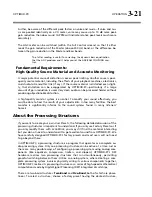
3-8
OPERATION
ORBAN MODEL 1101
In professional broadcasting environments, you will achieve best results if Engineer-
ing, Programming, and Management go out of their way to communicate and co-
operate with each other. It is important that Engineering understand the sound that
Programming desires, and that Management fully understands the trade-offs in-
volved in optimizing one parameter (such as loudness) at the expense of others
(such as distortion or excessive density).
Never lose sight of the fact that, while the listener can easily control loudness, he or
she cannot make a distorted signal clean again. If such excessive processing is per-
mitted to audibly degrade the sound of the original program material, the signal is
irrevocably contaminated and the original quality can never be recovered.
Sound for Picture Applications: Controlling Dynamic Range
The most crucial commandment in sound for picture is this:
dialog must always be
intelligible.
Sound for picture is usually heard under less-than-ideal conditions and
its dynamic range must be controlled accordingly. Apartment-dwellers must set their
volume controls to avoid disturbing neighbors or even other members of the family.
At the quiet side, intelligibility of dialog is often impacted by environmental noise
such as children playing or a dishwasher going in the kitchen. When one considers
that the hearing acuity of a significant portion of the audience is somewhat im-
paired compared to that of a healthy 20-year-old, one concludes that
the dynamic
range of dialog must not exceed 15dB
if it is to be intelligible to 99% of viewers un-
der common domestic viewing conditions. Feature-film dynamic range is inappropri-
ate for home viewing (except in dedicated home theaters) and the dynamic range of
a significant portion of the audio from video source material must be compressed to
best serve the audience. The challenge (which OPTIMOD-PC effectively meets) is to
compress dynamic range unobtrusively.
OPTIMOD-PC can be adjusted so that the output sounds as close as possible to the
input at all times (using the Two-Band Protection Limiter preset),
or
so that it sounds
open but more uniform in frequency balance than the input (using the Two-Band
structure or running the Five-band structure with slow release time), or so that it
sounds dense, quite squashed, and very loud (using the Five-band structure with
faster release times).
In television audio, inconsistent loudness between channels or program elements is
annoying, so the dense, loud setup is never appropriate. The 1101 offers two-band
and five-band presets (whose names begin with “TV”) that exploit the AGC’s and
multiband compressor’s compression ratio controls to subtly control dynamic range
in sound for picture applications. These presets effectively and unobtrusively main-
tain dialog intelligibility while retaining a sense of dynamic range, allowing low-
level elements to be heard easily. Meanwhile, the CBS Loudness Controller prevents
subjective loudness from exceeding a preset ceiling.
The preset tuning controls on the 1101 give you the flexibility to adapt the process-
ing to individual program segments. In most cases, your goal should be to choose
the type of processing that best optimizes dynamic range while controlling the
loudness of the loudest sounds so that they are not irritating and are consistent with
Summary of Contents for Optimod-PC 1101
Page 4: ......
Page 14: ......
Page 121: ...OPTIMOD PC OPERATION 3 1 Section 3 Operation Figure 3 1 The OPTIMOD PC Control Application...
Page 192: ...3 72 OPERATION ORBAN MODEL 1101...
Page 204: ......
Page 210: ......
Page 212: ...5 2 UNINSTALLATION ORBAN MODEL 1101...
Page 236: ......
















































